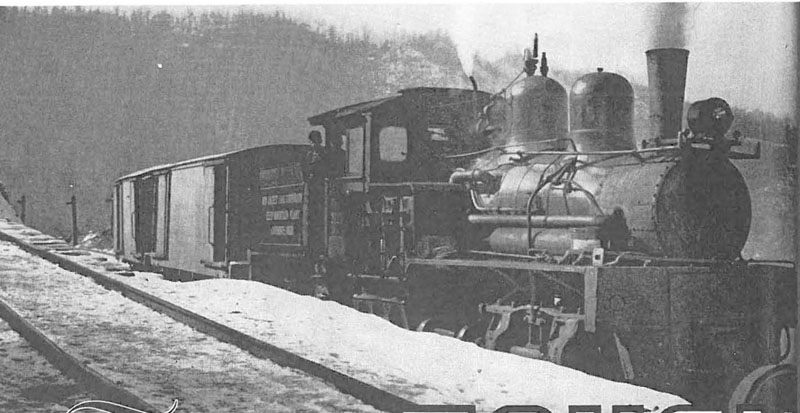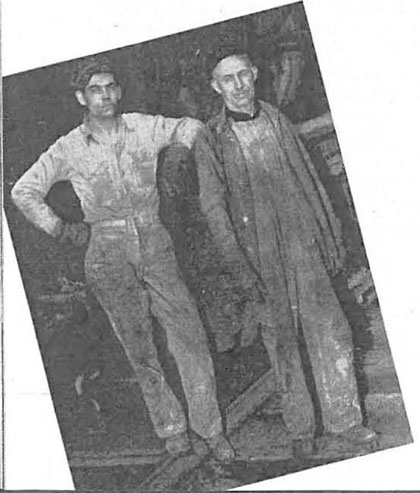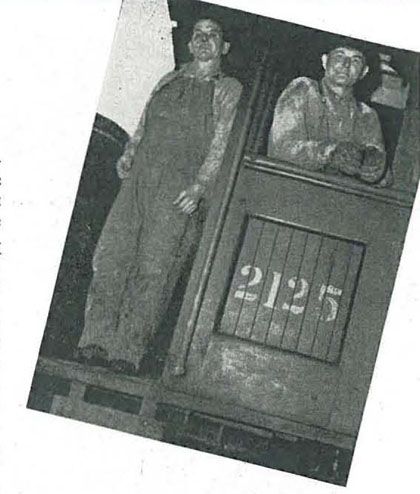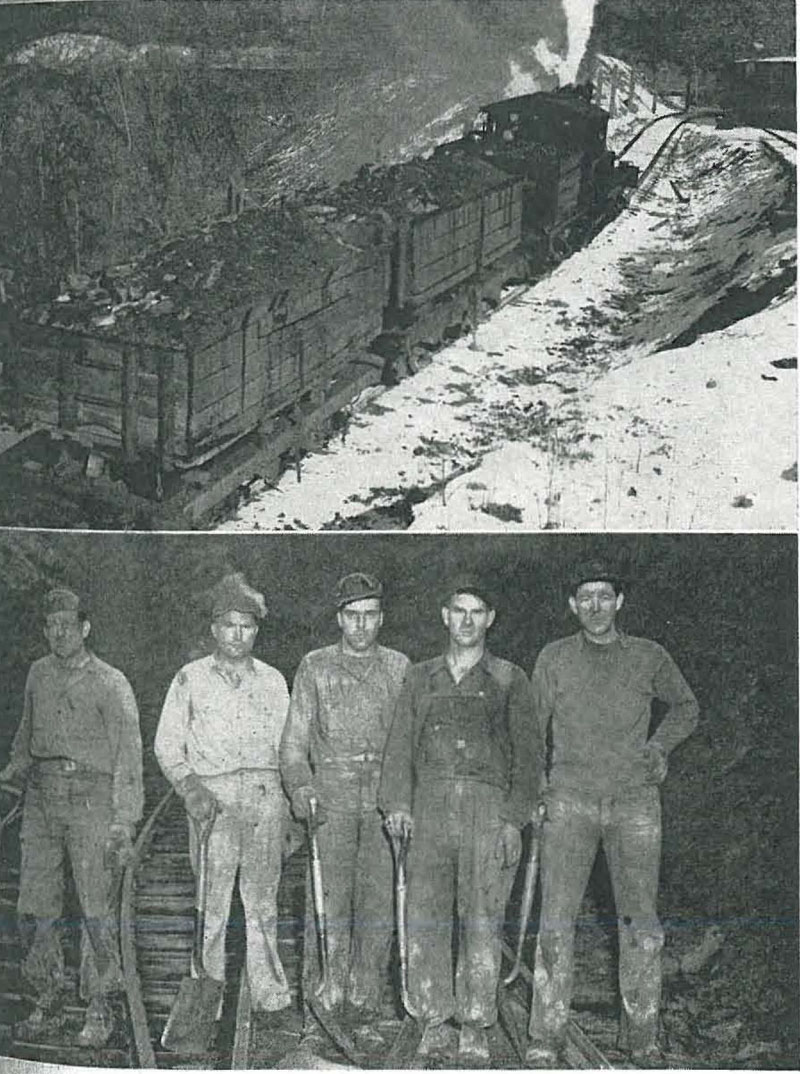Tiny But Tough
The Keen Mountain Railroad-Narrow Gauge Coal
Mine Carrier-Does An Uphill But Vital Job

You won’t find its class rating recorded in the files of the Interstate Commerce Commission, nor its schedules in the Official Guide, but the 2.8 mile-long Keen Mountain Railroad is a mighty important little carrier just the same. It is as much a part of the life of the mining community of the Red Jacket Coal Corporation at Keen Mountain, Buchanan County, Va., as the numerous cows which graze between the highway and the Levisa River, the little, white-painted community church where the miners and their families worship, or the Norfolk and Western trains which serve the area.
The Keen Mountain Railroad, a 48-inch gauge line, is now enjoying the ninth year of a busy and useful life. Construction of the little railway was begun February 1, 1937, at the same time that the tipple, head house, and N. & W. sidings were being prepared for opening of the mine. Over the narrow-gauge roadbed and tracks rolled workers, timber, mining equipment and supplies, up the steeply-sloping sides of Keen Mountain. Today the railroad hauls men and supplies needed for operation of the mine and transports refuse to dumping sidings.
The narrow-gauge tracks start under the tipple, skirt the tipple tracks, switch back and cross State Highway No. 4. Opposite the highway there is another switch-back and the tracks then ascend the north side of Keen Mountain in grades ranging from five to eight per cent. About midway of the mountain, the roadbed meets a little valley and here there is another switchback and siding. Finally, after climbing a total vertical distance of 532 feet in 2.8 miles, the tracks reach the head house near the top of the mountain.
Rolling stock of the Keen Mountain Railroad consists of two Shay-type steam locomotives; two passenger cars, three 25-ton dump cars of the gondola type, and as many mine cars as needed for supply hauls. Frank L. Smith, superintendent of the Keen Mountain operations, frankly admits that the little railroad’s equipment is of neither the quantity nor the quality that would appeal to a bond broker or excite the interest of a tourist, but he declares that it will do a man-sized job. “Regardless of weather conditions, our little engines and cars chug up the mountainside with men and supplies, expediting our work and saving us a lot of time and human energy,” says Mr. Smith.
Shay No. 10 is a sturdy little “dinky” weighing 45 tons. Its eight driving wheels are 28 inches in diameter. Loaded, its tender carries two tons of coal and 1,500 gallons of water. This is the engine that is depended upon to do most of the work. Day after day it stoutly pushes up the steep grades of the mountain. Interesting is the fact that braking is done by either of two methods: A steam brake on the locomotive or with air brakes controlling the locomotive and cars. Cars, either empty or loaded, always are pushed up the mountain. Coming down, the locomotive is invariably at the head-end. These precautions prevent the cars from uncoupling and running away down the mountainside.
When No. 10 needs an overhauling, the mine’s emergency Shay, Engine No. 1935, will take to the rails. Despite the fact that No. 1935 has 10 tons less dead weight than its more vigorous and energetic sister, its drivers are of the same number and diameter. Its coal and water capacity are also the same -- two tons and 1,500 gallons, respectively.
In comparison with the latest versions of streamlined railway passenger equipment, the Keen Mountain Railway’s two passenger coaches come out second best, but they do boast electric lights and steam heat while passengers who yearn for air-conditioning may simply open the windows, of which there are two to the coach, with twice the number of doors.
Modern conveniences, however, are not the strong point of the road’s passenger coaches. The principal advantage is adequate seating capacity. Commodious seats of the large bench type extend crosswise in the cars providing plenty of room for 50 men with only the minimum of elbow nudging.
But with all of these attractions, many of the Keen Mountain coal diggers pass up a ride on the train -- and a free one at that -- and walk up the mountainside to the mine entrance over a well-graded path. Perhaps the reason for this indifference is the fact that the miners consistently arrive at the mine ahead of the train!
Not to be outdone by the Norfolk and Western and other great railway systems, the Keen Mountain Railroad has its own skilled operations and maintenance personnel. Early each workday morning, Engineer M. D. Cuthbertson and Fireman Robert Cuthbertson report for duty and fire up Shay No. 10 for her 18-hour vigil of pushing and pulling.


The Cuthbertson crew is a father and son combination, Robert, the son, having fired for his father ever since the railroad began operations in 1937, except for the time he served as a soldier in World War II. They operate the train on the first shift, from 6:30 a. m. to 3:15 p. m. W. B. Bailey, engineer, and Bill Stacey, fireman, take over the second shift operations at 3:30 p. m., and exhort and cajole the little locomotive into carrying on her routine until 11:45 p. m., when she comes down the mountain for a needed and deserved rest of six and one-half hours.

The “maintenance-of-way department” is headed by Foreman W. M. Tickle who, with a crew of seven men, keeps the roadbed and tracks in safe operating condition. One important job performed by Mr. Tickle and his men is that of changing sidings at the dumps along the mountainside. As the refuse from the head house and tipple is dumped by the train crews, the sidings must be moved from time to time to the edge of the embankments to avoid a second handling.
This is the Keen Mountain Railroad. It s story is that of a little enterprise that is doing a sturdy, steady job of helping to produce &rlquo;the power behind the nation,” during the years of peace, industry and productivity that challenge it and America to their best efforts.
N&W Magazine, February 1946, pp. 60-61
